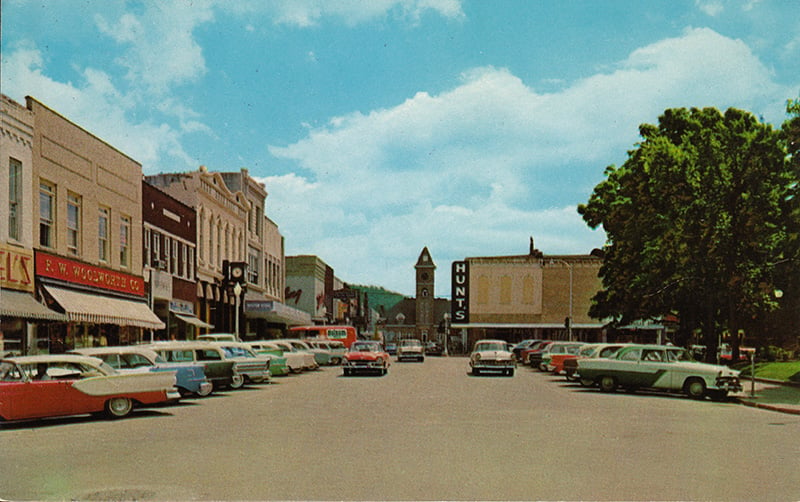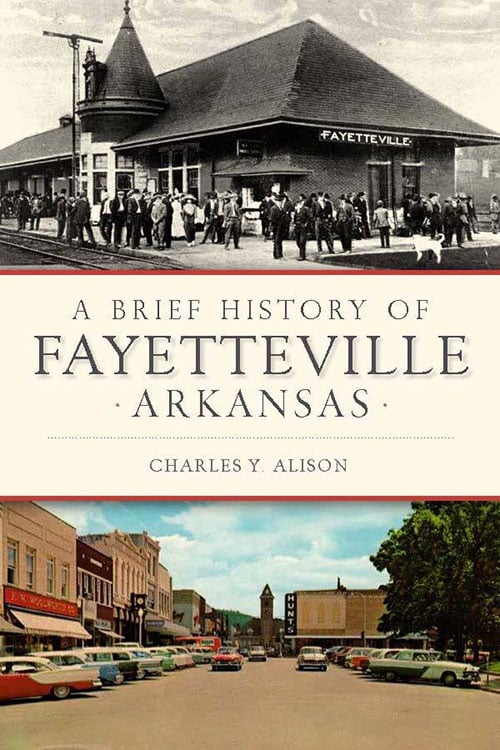
Although nearly all the buildings in this 1950s postcard looking east on Center Street have disappeared, the Historic Washington County Courthouse still stands at the end of the street.
Courtesy photo
Read a few “Best Places to Live” type of lists and you’ll keep seeing the city of Fayetteville listed among the top choices.

What: Booking signing for “A Brief History of Fayetteville”
When: 1:30-3 p.m. April 15
Where: Headquarters House at 118 E. Dickson Street, Fayetteville
Info: washcohistoricalsociety.org
Search back in its history and you’ll find that’s been the case for a while. Fayetteville decreased in population only one decade – the 1860s, when the Civil War came to the heart of the town, destroying homes and displacing residents in its wake. But Fayetteville has longed been marked by quirky residents, a beautiful town square and sustained growth, among other charms.
Author Charlie Alison, who has called Fayetteville home for more than 50 years, agrees there’s something special about the town. Perhaps when he graduated from college there weren’t many jobs in this area. He was lucky enough to find one as a reporter at the Northwest Arkansas Times newspaper, and he now serves as an Executive Editor for University Relations at the University of Arkansas. Soon enough, however many of those who went to Little Rock and Dallas to find work in the early 1980s started coming back home. And people just keep coming.
There’s a lot to love about this city on the hill, and Alison hopes he has captured some of it in the new book “A Brief History of Fayetteville,” which debuted earlier this month courtesy of the History Press. “A Brief History of Fayetteville” chronicles many important moments in Fayetteville, starting from its founding in 1828 to the present day.
Alison had the notion to write the book a decade ago, and he started by pitching the idea to the late John Lewis. The former Bank of Fayetteville president and town scholar got behind the idea. But then Alison, who had recently graduated with a master’s degree of journalism with an emphasis in history, found a job. The project got shelved, at least temporarily. In the meantime, Alison put together a pictorial history of Fayetteville with Ellen Compton and started a website dedicated to Fayetteville history.

This depot, the second built on the spot, stood on Dickson Street at the same location as the current depot building, which is now converted to restaurants.
Postcard from the collection of Charlie Alison
When the History Press asked him about two years ago if he knew someone who could write a book about the history of Fayetteville, he knew what to do.
“‘If I don’t write this, someone else will,'” he told himself.
So, he wrote the book, pulling from his research for the website and spending hours at the Fayetteville Public Library, the Special Collections department of the University of Arkansas and reading through “Flashback,” a publication of the Washington County Historical Society.
What he found was a portrait of a strong, resilient town. The city not only bounced back from the Civil War but also from a tornado in 1880 that flattened parts of the Fayetteville Square and traveled up Mount Sequoyah. At least two people were killed, and many businesses were destroyed.

This aerial image appeared in the 1951 Razorback yearbook and shows most of the campus as it appeared looking west. Hill Hall and Gray Hall, both captured in this photo, have since been replaced by Mullins Library.
Courtesy photo
“The city did a really good job rebuilding after that,” Alison said. Just as it had about 15 years earlier in the wake of the Civil War, which saw the city change hands between Union and Confederate forces. Alison credits much of the resiliency of this town to the presence of the University of Arkansas, which was created in the early 1870s. Even during tough economic times such as Reconstruction, the tornado and the Great Depression, federal dollars that supported the university helped bolster the town, he said. Fayetteville may have suffered, but not as much as other surrounding towns.
Alison said the focus of his book was the Civil War era, modern history and the elements that stitched them together. He purposefully avoided a few topics, such as Dickson Street, because a previous history book – specifically, Ethel Simpson and Tony Wappel’s “Once Upon Dickson” from 2008 – already covered that ground. Alison said his book is the first comprehensive narrative history written since the centennial celebration of the city in 1928.

The North School was the first public school building for European American students, built at a time when the city’s education system was segregated. It stood on the grounds of the present-day Washington Elementary School.
Postcard from the collection of Charlie Alison
“I was sort of flabbergasted no one had written a more comprehensive narrative,” Alison said.
The book is for sale through major online book retailers and locally through Nightbird Books, Collier Drug Stores and the Headquarters House Museum on East Dickson Street in Fayetteville. Alison will sign copies of his book at the Headquarters House on Saturday (April 15) as part of the museum’s annual re-enactment of the Battle of Fayetteville. The commemoration takes place from 10 a.m. to 3 p.m., and Alison will sign books from 1:30-3 p.m.
Alison said he will likely update his Fayetteville history website more frequently now that he has more free time, and will contemplate his next project, perhaps a book on Silas Hunt, a University of Arkansas law student who was key to the integration movement in the South.



